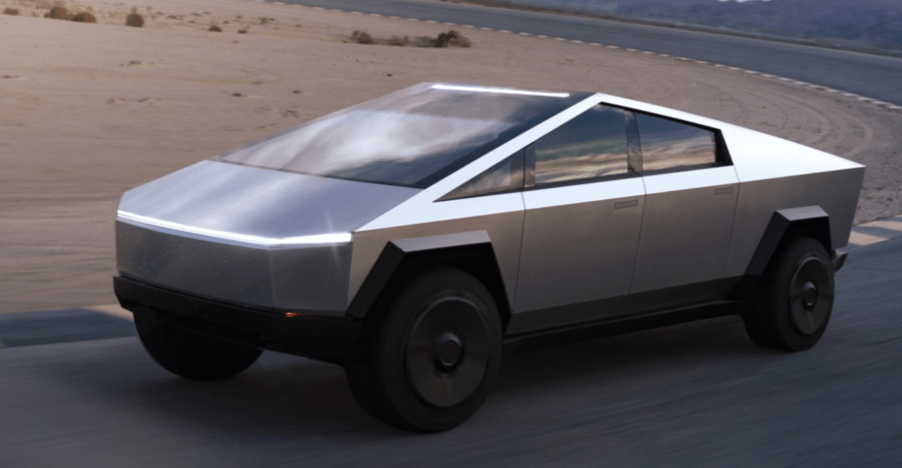
Does the Latest Tesla Model 3 Performance Update Preview a Faster Cybertruck?
Although Tesla’s over-the-air updates have occasionally caused problems, they’ve also been a fundamental benefit for the EV manufacturer. Where updating something like a Ford F-150 can take months or years just to plan, Tesla can implement changes essentially overnight. And some of these changes can be dramatic. The already-quick Model 3 recently received a free performance boost from Tesla, BGR reported. And now, Tesla has introduced another Model 3 performance upgrade. Updates like this could be a sign of what Tesla plans on doing with the Cybertruck.
Tesla Model 3 Performance Update details

According to Roadshow and Road & Track, some Tesla Model 3 owners had spotted information regarding an “Acceleration Boost” feature. This follows the recent release of a software update that unlocked approximately 5% more power from the Model 3’s motors, according to Motor1. And based on several owners’ videos, that update’s improvements were definitely noticeable.
However, Tesla has now released an additional performance update for dual-motor AWD Model 3 owners. At the moment, Tesla claims a non-updated dual-motor Model 3 can go 0-60 in 4.4 seconds. With the $2000 update, the automaker claims the time shrinks to 3.9 seconds. And according to users on the r/TeslaMotors sub-Reddit, that number may actually be a little on the conservative side.
It would also, according to Road & Track, place the dual-motor Model 3’s 0-60 time within a second of the more-expensive Performance version. Considering the Long-Range dual-motor Model 3 costs $8000 less than the Performance one, this is actually a bit of a performance bargain.
The Performance Model 3 does have a higher top speed—162 mph vs 145 for the Long-Range—but in the vast majority of situations, acceleration is more important than top speed.
Tesla has not commented on how this software update will impact range or battery longevity.
Could there be one for the Cybertruck in the works?
While the Tesla Cybertruck still isn’t out yet, there’s no reason to doubt Tesla couldn’t release over-the-air updates when it does reach production. Updates like the Model 3’s are basically video game patches and DLC.

In addition, part of the appeal of electric motors is the ability to tune them through software, not just hardware. And, just like video games or other computer software, once the initial investment is paid off, additional content is a steady source of revenue. It just takes time to properly code and de-bug the package. It’s not impossible that, after some time, Tesla may lower the Model 3’s performance update price.
Plus, the Tesla Cybertruck may, in fact, need some updates to stay competitive.
Would a Tesla Cybertruck update be just about speed?

Considering the Tesla Cybertruck may compete not with light-duty pickups, but medium- or heavy-duty ones, some additional tweaking may be required. And adding speed may not be necessarily the best place to start.

Although even the base Cybertruck can out-accelerate a medium-duty pickup like the Ford F-250, it suffers when it comes to driving range. And when it comes to towing, electric trucks need all the extra range they can get. Although, as Road & Track explained, range is usually extended through hardware decisions, that isn’t always the case. For example, as Car and Driver reported, Jaguar used information gained from racing to increase the electric I-Pace’s range with software updates.
Range isn’t the only thing that matters for towing. There, torque matters more than horsepower. Here, the Cybertruck also struggles to compete with its diesel and gasoline rivals. Even the tri-motor AWD Cybertruck can’t tow as much as an F-250, Ram 2500, or Silverado 2500. Never mind an F-350 or a 3500HD Ram or Chevy. But unfortunately, that’s not necessarily something that Tesla can improve on the Cybertruck with just software updates.

Ecotuned’s electric F-150 doesn’t have as much power as a Cybertruck, but its tow-rating is higher because of its transmission and lighter weight. Careful gear ratio choices are what allow the Suzuki Jimny to rock-crawl, and gave the Cayenne Transsyberia Rally improved performance. And Ford went to aluminum for the F-Series’ construction because decreasing weight meant the trucks could tow and carry more. These are issues Tesla will have to address with Cybertruck hardware changes, not a software update.


